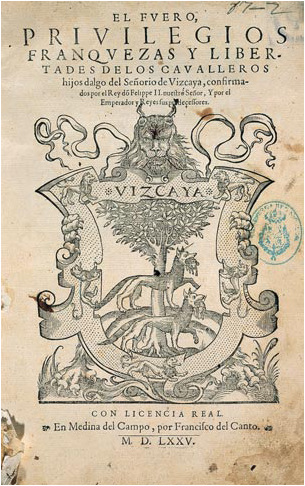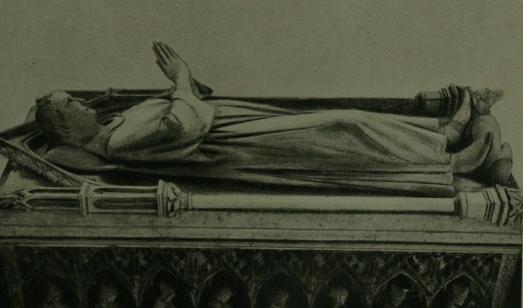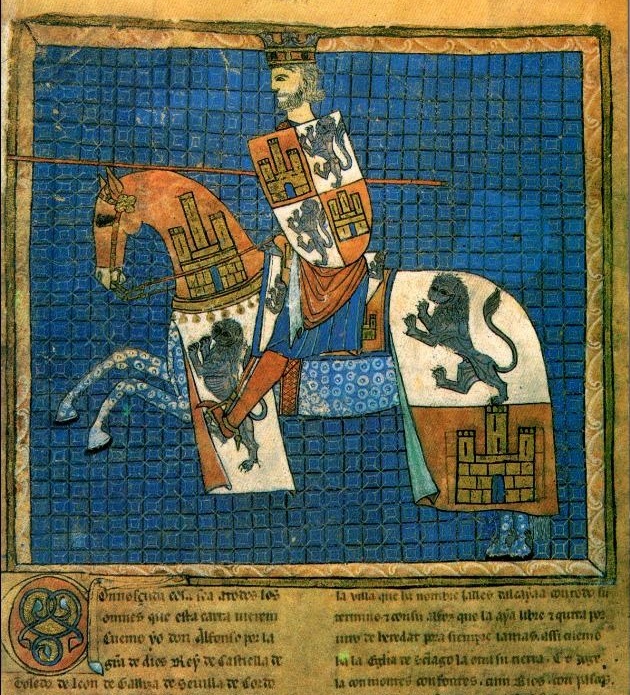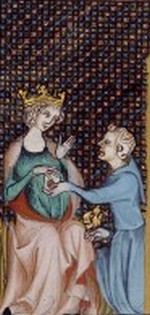|
Theobald V Of Champagne
Theobald II (6/7 December 1239 – 4/5 December 1270) was King of Navarre and also, as Theobald V, Count of Champagne and Brie, from 1253 until his death. He was the son and successor of Theobald I and the second Navarrese monarch of the House of Blois. After he died childless, the throne of Navarre passed to his younger brother, Henry I. Biography Early years Theobald was the eldest son of Theobald I of Navarre and his third wife, Margaret of Bourbon. He succeeded to his father's titles on his death at only fourteen years of age. His mother acted as regent with James I of Aragon until 1256, when Theobald came of age. On 27 November, he affirmed the Fueros of Navarre, which limited his power by putting him under the counsel of a tutor from among the aristocracy. He could not make judgements without a council of twelve (a jury) of noblemen. Theobald was not content, however, to be so restricted in royal prerogative before his twenty-first birthday. He received the rites ... [...More Info...] [...Related Items...] OR: [Wikipedia] [Google] [Baidu] |
King Of Navarre
This is a list of the kings and queens of kingdom of Pamplona, Pamplona, later kingdom of Navarre, Navarre. Pamplona was the primary name of the kingdom until its union with Kingdom of Aragon, Aragon (1076–1134). However, the territorial designation Navarre came into use as an alternative name in the late tenth century, and the name Pamplona was retained well into the twelfth century. House of Íñiguez, 824?–905 The Íñiguez dynasty are credited with founding the Navarrese kingdom (of Pamplona) in or around 824 when they are said to have risen against an attempt to extend Franks, Frankish (Carolingian) authority into the region. The Cordoban sources referred to them as sometimes-rebellious vassals, rather than in the manner used to refer to the Christian realms outside their control. They were supplanted in 905 when an anti-Cordoba coalition placed the succeeding Jiménez dynasty in power. House of Jiménez dynasty, Jiménez, 905–1234 In 905, a coalition of neighbors ... [...More Info...] [...Related Items...] OR: [Wikipedia] [Google] [Baidu] |
Fueros
(), (), (), () or () is a Spanish legal term and concept. The word comes from Latin , an open space used as a market, tribunal and meeting place. The same Latin root is the origin of the French terms and , and the Portuguese terms and ; all of these words have related, but somewhat different meanings. The Spanish term has a wide range of meanings, depending upon its context. It has meant a compilation of laws, especially a local or regional one; a set of laws specific to an identified class or estate (for example , comparable to a military code of justice, or , specific to the Roman Catholic Church). In many of these senses, its equivalent in medieval England would be the custumal. In the 20th century, Francisco Franco's regime used the term for several of the fundamental laws. The term implied these were not constitutions subject to debate and change by a sovereign people, but orders from the only legitimate source of authority, as in feudal times. Characteris ... [...More Info...] [...Related Items...] OR: [Wikipedia] [Google] [Baidu] |
Louis Of France (1244–1260)
Louis of France (21 or 24 February 1244 – 11 January 1260) was the eldest son of King Louis IX of France and his wife Margaret of Provence. As heir apparent to the throne, he served as regent for a brief period. Regency In 1248, King Louis and Queen Margaret traveled to Egypt to participate in the Seventh Crusade. During their absence, his grandmother, Blanche of Castile, acted as regent. However, when she died in 1252, his parents were still crusading and the eight-year-old Louis was appointed regent. He did not actually rule the country; real power was in the hands of a royal council, led by his uncles Alphonse and Charles. Nevertheless, royal deeds were sealed in his name, and correspondence to the government was addressed to him personally. The basis of the arrangement was the unwritten (at the time) principle of primogeniture in French law: in the absence of written instructions to the contrary, the king's eldest son automatically became regent during the kin ... [...More Info...] [...Related Items...] OR: [Wikipedia] [Google] [Baidu] |
Berengaria Of Castile, Lady Of Guadalajara
Berengaria of Castile (Seville, 1253 – Guadalajara, 1300), Infanta of Castile and Lady of Guadalajara in her own right. She was the eldest child of King Alfonso X of Castile and Violante of Aragon. She was probably named after her paternal great-grandmother, Queen Berengaria of Castile. As the first-born daughter, she was the heiress to the throne until the birth of her brother, the Infante Fernando de la Cerda. Her paternal grandparents were King Ferdinand III of Castile and his first wife Elisabeth of Swabia and her maternal grandparents were King James I of Aragon and his second wife Violant of Hungary. Life Berengaria was born in Seville at the end of 1253, and her first years were spent in that city, being cared for by a noble named Don Romero. In the Cortes of Toledo in 1254 she was recognized as heir presumptive due to the lack of male descent from King Alfonso X. In the fall of 1254, Queen Violante gave birth a second daughter, Beatrice, prompting Alfonso X to con ... [...More Info...] [...Related Items...] OR: [Wikipedia] [Google] [Baidu] |
Alfonso X Of Castile
Alfonso X (also known as the Wise, ; 23 November 1221 – 4 April 1284) was King of Castile, Kingdom of León, León and Kingdom of Galicia, Galicia from 1 June 1252 until his death in 1284. During the April 1257 Imperial election, election of 1257, a dissident faction chose him to be king of Germany on 1 April. He renounced his claim to Germany in 1275, and in creating an alliance with the Kingdom of England in 1254, his claim on the Duchy of Gascony as well. Alfonso's scientific interests—he is sometimes nicknamed the Astrologer (''el Astrólogo'')—led him to sponsor the creation of the Alfonsine tables, and the Alphonsus (crater), Alphonsus crater on the Moon is named after him. He also sponsored the work of historians who, for the first time since Isidore of Seville in , placed Spain in the context of world history. As a lawmaker he introduced the first vernacular law code in Castile, the ''Siete Partidas''. He created the Mesta, an association of sheep farmers in the cen ... [...More Info...] [...Related Items...] OR: [Wikipedia] [Google] [Baidu] |
Isabelle Of France, Queen Of Navarre
Isabella of France (2 March 1241 – 17 April 1271) was Queen of Navarre by marriage to Theobald II of Navarre, a daughter of Louis IX of France and Margaret of Provence. Life At the All Saints Parlement in 1254, Theobald of Navarre requested Isabella's hand in marriage. In an attempt to resolve the inheritance of Navarre, Louis declined Theobald's request until he reconciled with his sister, Blanche of Brittany. Upon the reconciliation, Louis agreed to Isabella marrying Theobald. The Archbishop of Rouen celebrated the marriage between Isabella and Theobald II, King of Navarre and Count of Champagne, on 6 April 1255 in Melun. Isabelle became Queen consort of Navarre. Together with her husband and her father, the very pious Isabella travelled with the Eighth Crusade in July 1270. Her father died there in August of the same year. Then, in December, Isabella's husband died of an epidemic while in Sicily. After the deaths of both her father and husband, Isabella returned to Franc ... [...More Info...] [...Related Items...] OR: [Wikipedia] [Google] [Baidu] |
Louis IX Of France
Louis IX (25 April 1214 – 25 August 1270), also known as Saint Louis, was King of France from 1226 until his death in 1270. He is widely recognized as the most distinguished of the Direct Capetians. Following the death of his father, Louis VIII, he was Coronation of the French monarch, crowned in Reims at the age of 12. His mother, Blanche of Castile, effectively ruled the kingdom as regent until he came of age, and continued to serve as his trusted adviser until her death. During his formative years, Blanche successfully confronted rebellious vassals and championed the Capetian cause in the Albigensian Crusade, which had been ongoing for the past two decades. As an adult, Louis IX grappled with persistent conflicts involving some of the most influential nobles in his kingdom, including Hugh X of Lusignan and Peter I of Brittany. Concurrently, England's Henry III of England, Henry III sought to reclaim the Angevin Empire, Angevin continental holdings, only to be decisively def ... [...More Info...] [...Related Items...] OR: [Wikipedia] [Google] [Baidu] |
Occitan Language
Occitan (; ), also known by its native speakers as (; ), sometimes also referred to as Provençal, is a Romance language spoken in Southern France, Monaco, Italy's Occitan Valleys, as well as Spain's Val d'Aran in Catalonia; collectively, these regions are sometimes referred to as Occitania. It is also spoken in Calabria ( Southern Italy) in a linguistic enclave of Cosenza area (mostly Guardia Piemontese) named Gardiol, which is also considered a separate Occitanic language. Some include Catalan as a dialect of Occitan, as the linguistic distance between this language and some Occitan dialects (such as the Gascon language) is similar to the distance between different Occitan dialects. Catalan was considered a dialect of Occitan until the end of the 19th century and still today remains its closest relative. Occitan is an official language of Catalonia, Spain, where a subdialect of Gascon known as Aranese is spoken (in the Val d'Aran). Since September 2010, the Par ... [...More Info...] [...Related Items...] OR: [Wikipedia] [Google] [Baidu] |
History Of The Basque People
The Basques () are an indigenous ethno-linguistic group mainly inhabiting the Basque Country (adjacent areas of Spain and France). Their history is therefore interconnected with Spanish and French history and also with the history of many other past and present countries, particularly in Europe and the Americas, where a large number of their descendants keep attached to their roots, clustering around Basque clubs which are centers for Basque people. Origins First historical references The Hand of Irulegi, a 2,200 years old (1st century BC) bronze hand silhouette was unearthed in June 2021 from a Navarrese Lakidain hillside and is the oldest Basconic text to date. Basconic scripts appears to reflect Celtiberian regional influence, with archaeo-linguists able to identify the Basque sound "''SORIONEKU''" (Modern Basque: ''Zorioneko;'' English: ''blessed, fortunate, lucky'') among other words. This evidence suggests that the Vasconic substrate predates the timeline previou ... [...More Info...] [...Related Items...] OR: [Wikipedia] [Google] [Baidu] |
Roncesvalles
Roncesvalles ( , ; ; ; ; ) is a small village and municipality in Navarre, northern Spain. It is situated on the small river Urrobi at an altitude of some in the Pyrenees, about from the French border as the crow flies, or by road. History Battle of Roncevaux Roncesvalles is famous in history and legend for the death of Roland in 778, during the Battle of Roncevaux Pass, when Charlemagne's rearguard was destroyed by Basque tribes. When a party of horsemen from the Kingdom of Navarre arrived at the Duchy of Burgundy in 1439 to negotiate Prince Charles of Navarre's marriage to Agnes of Cleves, the Duke of Burgundy's niece, the prior of Roncesvalles was their chief ambassador. He was described as a "noble knight". The small collegiate church contains several curious relics associated with Roland. The battle is said to have been fought in the valley known as Valcarlos, which is now occupied by a hamlet bearing the same name, and in the adjoining pass of Ibañeta ( Roncevau ... [...More Info...] [...Related Items...] OR: [Wikipedia] [Google] [Baidu] |
Torralba Del Río
Torralba del Río is a town and municipality in the province and autonomous community of Navarre, northern Spain Spain, or the Kingdom of Spain, is a country in Southern Europe, Southern and Western Europe with territories in North Africa. Featuring the Punta de Tarifa, southernmost point of continental Europe, it is the largest country in Southern Eur .... The Santuario de Nuestra Señora de Codés is located within the Torralba del Río municipal term in the Codés Range. References External links TORRALBA DEL RIO in the Bernardo Estornés Lasa - Auñamendi Encyclopedia (Euskomedia Fundazioa) Municipalities in Navarre {{navarre-geo-stub ... [...More Info...] [...Related Items...] OR: [Wikipedia] [Google] [Baidu] |








